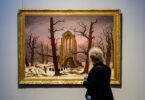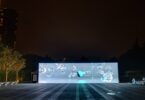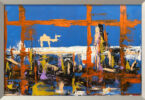Katy Gillett
A nine-metre, nearly three-tonne black glass sculpture is suspended over the central nave of a deconsecrated church in Venice.
It’s the centrepiece of Chinese artist Ai Weiwei‘s latest exhibition, titled The Human Comedy: Memento Mori, which opens on Sunday at San Giorgio Maggiore, opposite Venice’s St Mark’s Square.
It’s his first glass sculpture, made on the Venetian island of Murano, and has a foreboding subtitle: Memento Mori, Latin for “remember you must die”. Its name is a reference to Dante’s 14th-century poem, The Divine Comedy.
The huge hanging artwork is part-chandelier, part-ossuary, with intricately hung moulded glass skeletons and skulls, both human and animal, balanced with glass-blown human organs and scattered likenesses of the Twitter bird logo and surveillance cameras, hinting at the darker side of technology.
It took three years to realise with assistance from artists at a glass studio on Murano employing three techniques: traditional Murano blown glass, wax moulds and injection moulds.
It is composed of 2,000 handblown glass parts and weighs 2,700 kilograms.
He says it warns against hubris in what he calls “such a troublesome time”. “We are talking about many, many things. We are talking about immigrants, about deaths, about the war, about many, many issues,″ Ai told the Associated Press in Venice.
“The theme of the show is death,” he told The Art Newspaper. “Death is always there accompanying us. But we don’t like to acknowledge it — we tend to think of it as something that happens to other people”.
The new show, a three-year collaboration with Berengo Studio, includes 32 new and recent sculptures by Weiwei, all staged in the 16th-century church. It’s the first time the artist will host an exhibition of glass works, as it is not a medium he is particularly known for, although it’s not the first time he’s worked with it.
“Glass is a material that is fragile and precious,” the artist told the arts publication. “In ancient Greek tombs, glass was used to make tear bottles which contained the tears that the living shed for the dead.”
“Ai has always known how to subvert and play with power structures and this work is no different,” studio founder Adriano Berengo said.
Tourists wandering in from the water bus were delighted that they had stumbled into an exhibit by the renowned dissident artist.
“It is metal? When I first saw this I thought it represented hell,″ Kenneth Cheung, a Hong Kong native now living in Toronto, Canada, said as he checked out the imposing glass sculpture. “Being in a church, it is even stronger, more powerful.”
The exhibition runs until November 27 in Venice. From there, the hanging sculpture will go to the Design Museum in London and then, hopefully a buyer, Berengo said.
“It has to be a big museum. Otherwise, how can you keep an artwork like that?”
In June last year, Weiwei unveiled the seven-metre-tall Gilded Cage, meant to portray the physical and psychological constraints of life as a refugee, at Britain’s Blenheim Palace.
:quality(70)/cloudfront-eu-central-1.images.arcpublishing.com/thenational/4FIXLJJP3MEB6QCNU4O73XYQVE.jpg)
The artwork previously stood at the gates of New York City’s Central Park after it was put on display there in 2017, its prison-like fences jarring intentionally with the beautiful surroundings.
Weiwei, 65, moved to Britain from Germany in 2019 and has long highlighted the plight of refugees and migrants in his artwork.
Courtesy: thenationalnews






